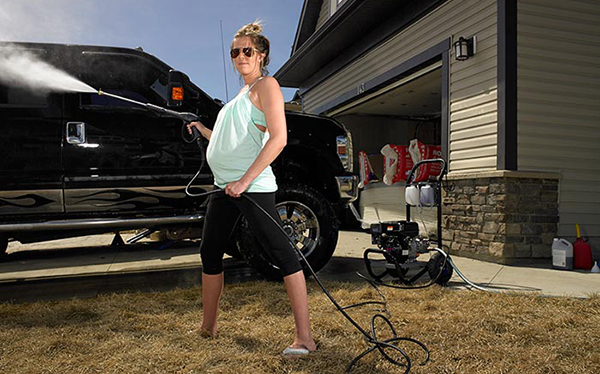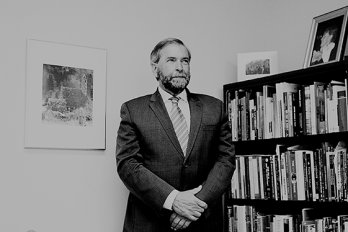Not many people come to Fort McMurray, the notorious Alberta boom town on the edge of one of the world’s largest industrial developments, to commune with the great northern woods. Most are here for the overtime, for the paid vacations, for the blue-collar jobs that pay six figures, for the work. This means that all of the bad things you’ve heard about Fort McMoney are true: the traffic really is murderous, there are liquor stores (many open until 2 a.m.) in every strip mall, and the place has a depressingly large population of desperately lonely guys blowing ridiculously fat paycheques on steroids, tattoos, monster trucks, and peelers.
But one secret almost never gets out of the Mac. It is beautiful up here, like, drop-dead gorgeous, particularly come late May, when the northern hemisphere tilts sunward and brutal winter turns, with whiplash suddenness, into glorious summer. Lured out of my motel room by a sun that refuses to set (we’re at fifty-seven degrees north, about the same latitude as Novosibirsk, the capital of Siberia), I decide to do what almost nobody here does: go for a walk in the woods.
Striding past a sign entreating me to Be BearSmart, I find myself in a different world. Not the temperate rainforest of my West Coast youth, where Douglas fir trunks undergird the canopy like Gothic buttresses, or the tranquil pathways of the eastern deciduous forest, with their colonnades of maple and oak. Here, I walk among Jack pines, backlit and lichen draped, straight out of a Tom Thomson painting, and centenarian black spruce that soar skyward like the corner posts of a Scandinavian stave church. This is no flyover forest, some easily dismissed strip of scrubby green between cottage country and tundra. It is substantial woodland, the historic stomping ground of the coureurs de bois, the numinous homeland of Dene and Cree.
Scrambling over a deadfall tamarack on a switchback, down to a creek steeped to orange-pekoe opacity with the tannins of dead foliage, I find a Hinterland Who’s Who of factoids about the great northern woods scrolling through my mind. The Canadian boreal forest contains a quarter of the world’s wetlands, provides habitat to five billion birds, and is a carbon sink twice as effective as any tropical rainforest. The magic of filtered light, birdsong, and aromatic organic compounds works on my senses as surely as Gregorian chants, stained glass, and incense.
The gurgling of a creek recedes behind me, and I detect a new sound, not the percussion of a woodpecker’s beak against dry bark but a different kind of rapping: amplified, urgent, urban. As I walk uphill, spruce transitions to spindly aspen and, abruptly, to a fluorescent greenbelt of closely trimmed lawn. In the space of a few metres, the boreal zone has given way to barbecue-topped backyard decks. Gangsta rap blasts from an invisible sound system in a basement suite, and as I follow a right-of-way between vinyl-clad ranch homes, I catch the whiff of a bong hit slowly exhaled through a window screen.
Then I’m in a maze of tightly packed houses that could have been airlifted from the exurbs of Phoenix, Orlando, or Las Vegas. Every metre of curb space seems taken up by late-model SUVs, motorboats, four-by-fours, and radically lifted pickups. On the sidewalk, a woman in a jet black burqa pushes twins in a navy blue stroller, and at a half-finished playground down the street, a half-dozen South Asian boys are schooling a good-humoured weightlifter in the finer points of cricket. This is another Fort McMurray you don’t hear about, a year-round community with bake sales, supermarkets, and elementary schools.
Up here, where bull moose–swallowing muskeg meets pavement, the baby boom’s glory days are being reenacted by a youthful, surprisingly multicultural workforce. But whether the Mac is destined to become a new Winnipeg, Saskatoon, or Calgary—a one-time frontier town grown into a real city with a fully diversified economy—depends entirely upon the industry on which it bets its future. To engineer the transition from hardbitten work camp in the frozen North, boosters of the bitumen boom are flying in urban designers from distant cities, planting the seeds of a blue-collar utopia. Officials talk of making Fort McMurray “a global model of sustainable living in the North.” They could well succeed, and this should have everybody else in Canada, and indeed the world, paying close attention to what such bold ambitions reveal about our future.
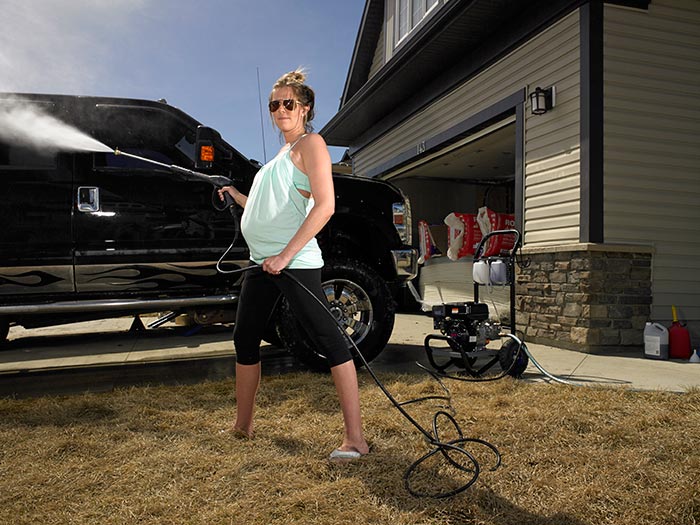 Genna Sharp washes a truck in the new subdivision of Eagle Ridge.
Genna Sharp washes a truck in the new subdivision of Eagle Ridge.
“I’ve been called crazy for staying in Fort McMurray,” says Tracey Peckford, who is curled up like a cat on a leather armchair in the living room of her year-old home. “But I couldn’t be happier. I love it here.” Her husband, Craig, who is bottle-feeding their newborn son, Liam, on the matching leather sofa, concurs. “There’s kids out on site, twenty-two years old, making 150 grand a year,” he says in a clipped East Coast accent. “Where else in the world could you earn that kind of money? ”
Craig, who came to Fort McMurray ten years ago from a dying mill town in central Newfoundland, easily earns that—and much more with overtime—in his work as a heavy equipment technician for Syncrude. Tracey, whose father and grandfather worked for Syncrude before her, makes about the same driving one of those oversized Tonka trucks used to haul ore in the open-pit mines.
“There’s twenty-one stairs just to get up to the cab,” she says. “They’ll carry a 400-tonne load of tar sands ore.” (One of the first things you learn in Fort McMurray is that people who actually work in the Athabasca tar sands call them by their real name, rather than the government- and industry-mandated label “oil sands.” You only need to get the sticky black goo on your hands once to know that bitumen is tar, pure and simple.) Tracey’s parents brought her to Fort Mac in diapers. As a teenager, she watched her high school friends leave town to go to college. When she couldn’t make a living as a hairstylist, she got a job on site—working at the mines—and was instantly bringing in six figures toiling in the heated cab of a heavy hauler.
The hours are long. For Craig, today was typical: out the door at 6 a.m., an hour-long bus ride to work (for which he gets paid), punched in for his twelve-hour shift by 7:30. He usually gets home by eight, too late to see their three- and five-year-old boys, though tonight he left work early to get in some quality time with the baby. Shirley, their Filipina nanny, who lives in a suite in the basement, has already put the two older boys to bed.
The long days, says Tracey, are worth it: “We do six days on, six days off. It works out to half of the year and less, because we get paid vacations, paid sick time, all that stuff. Last year, we went to the Mayan Riviera, British Columbia, and Newfoundland to see Craig’s family, and lots of mini-vacations to Edmonton.” She sometimes worries about her boys’ future, what with the crime and drugs, but she can’t bring herself to say anything bad about her hometown. “It’s done nothing but great things for me.”
The Peckfords have built their brand new million-dollar home in the newest part of Fort McMurray, Eagle Ridge, a housing development so fresh that it still shows up on Google Earth as dirt and bulldozers. They also own two other properties in Fort McMurray, which they rent to tar sands workers. They have a kitchen full of the latest stainless steel appliances, a piano in the living room, and a motorcycle in the garage. Craig is thirty-two years old, Tracey twenty-eight. She figures she will be in a position to retire, as her father-in-law is about to do, by her mid-forties. Craig is in it for the boys: “It doesn’t matter where you go. It’s all what you make of a place.” Pushing up his sleeves, he shows me their names, Lucas Raymond and Owen Robert, and birthdates tattooed in copperplate script on his forearms. “I’ll find room for Liam yet.”
On the sidewalk, I pause to take in the good life, Fort Mac style. Parked in the Peckfords’ driveway are two trucks, a Suburban and a Sierra, plus a new trailer that sleeps ten. A For Sale sign is posted on the four-bedroom house next door, which is listed at $1.5 million. In the playground down the street, kids jockey for position on slides and monkey bars, more evidence of a demographic boom that is seeing up to 150 new births a month in a town with just three obstetricians. The scene recalls North America’s postwar suburban idyll, supersized with hydrocarbons.
Only the lucky few can afford these pricey subdivisions. Driving along curvilinear streets named after herons, cranes, and mergansers—the same species displaced from wetlands or left slicked with oil in tailings ponds—I watch single-family homes give way to four-storey townhouse complexes. After a white-knuckle drive down Highway 63, wedged between enormous flatbed trucks laden with porta-potties, bulldozer blades, and even a Greyhound-sized bus, I cross a bridge and find myself in a modest gridiron of streets nestled in the valley where the Clearwater River meets the Athabasca. If you mentally erase all of the national chain drive-throughs, you can picture the Hudson’s Bay trading post as it existed in 1870, a brave little island of humanity in the continent-spanning sea of the boreal forest.
Off the main drag, Franklin Avenue, I strike up a conversation with a young couple walking their French bulldog, and I get an altogether different take on life in the Mac. “This is the worst place I’ve ever been,” declares Brandon flatly. He is wearing black cut-off jean shorts, oversized round studs in his earlobes, and a sleeveless Motörhead T-shirt that displays his muscled, comprehensively tattooed arms. “I can’t wait to leave.”
“It’s very depressing,” says Alaina, whose Bettie Page bangs overhang black-rimmed glasses. “It isn’t a community. It has no soul.” They met in Vancouver. After Alaina got a job as a pastry chef, Brandon, who was struggling to make a living as a hotel chef, followed her to Fort McMurray and landed work as a heavy equipment operator. “I drive a dozer,” he says. “We mine the sellable gravel at the Husky pit. Ten days on, four days off. I leave home at 4:30 in the morning and get home after seven at night.”
Among the many things wrong with their Fort McMurray: the winters are brutal. Last year, the snow came at the beginning of October and lasted until May, and they had some minus-fifty-degree days when the whiskers on Brandon’s thick red beard actually snapped off. When there is an accident—as often happens on Highway 63, known as the Highway of Death—the hour-long drive home can turn into six. If they try to catch a movie, the multiplex will be sold out. They won’t go to bars because, with so much coke and crack around, the night always seems to end in a brawl. Even getting a double-double at Tim Hortons takes a half-hour despite a two-lane drive-through. When Alaina walks their dog, she gets catcalls from the windows of pickup trucks if she doesn’t cover herself completely. Tonight she is wearing track pants and a hoodie zipped to the neck.
We stop in front of their house, an ’80s bungalow with a small backyard. It is ringed by horsepower, with seven trucks, the smallest of them Brandon’s Ford F-150, parked in the driveway and on the curbs. “We’d invite you in,” says Brandon, “but it’s a piece of crap.” They pay $4,000 a month in rent, which they split with five other people, three of them from Newfoundland.
Alaina sits down on the lawn and gives their dog, Kesler, a belly scratch. “This is our life,” she says. “We either sit at home and do nothing, or we work.” He is thirty-four, she ten years younger. They have no plans to raise a family here. So what keeps them in Fort Mac? “The money,” says Brandon. “In two years, I’ve put sixty grand in the bank. I’ve bought a snowmobile, a quad, and a dirt bike. We’re saving to buy a house—but not in Fort McMurray. We don’t want to get comfortable. We want to go home.”
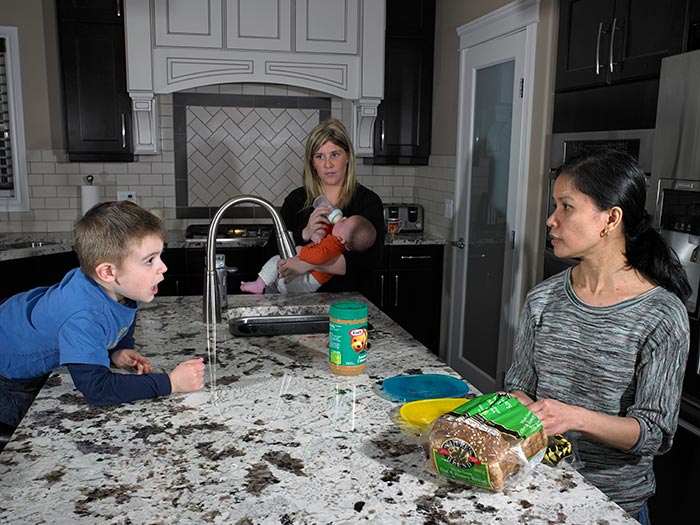
“Right now, more than a quarter of Fort McMurray’s population doesn’t live here year round,” Ron Taylor tells me as he takes me on a stroll down Franklin Avenue. “They fly in for a week to three months and leave behind a life and a family.” Though the town’s population is officially 76,000, continues the affable urban designer from Quebec, water records suggest that 30,000 more live here. Many rent basement rooms, or campers in city-limits trailer parks, for as much as $2,000 a month.
By 2017, Suncor, Syncrude, CNRL, and the other major employers are expected to slow down construction, shifting to what they call the “operations” phase. The day-to-day business of piping massive quantities of crude to foreign markets will require permanent residents. That means the area will need to retain more families—and families are going to want decent homes, movie theatres, schools, and restaurants. In other words, Fort McMurray will have to do a better job of convincing people like Brandon and Alaina to stick around for good.
Taylor oversees a team, made up of engineers and designers from as far away as Spain and Scotland, that will implement thirteen major projects meant to transform the rough-hewn downtown into an attractive urban centre. He was one of the masterminds who helped transform a desolate patch of London dockland into the twenty-first-century financial hothouse that is Canary Wharf. “We want this to be the kind of place you would live if you were an urban person in Montreal, or Toronto, or Vancouver,” he tells me. “The kind of place where people will come, will stay, will raise families. Because, as Richard Florida says, ‘We are where we live.’ ”
Sharing Taylor’s vision requires a vivid imagination. We are a block away from the Peter Pond Mall, the only shopping centre in town, whose parking lot is infamous, come closing time, for the fights outside the Boomtown Casino and Bailey’s Pub. Before meeting with Taylor, I walked past the Clearwater riverfront and saw a parliament of sunburned street people debating over a two-litre jug of port. I paused on Franklin Avenue to watch as some Mounties lowered a blue tarp over the body of a homeless man, one of the estimated 300 who sleep in shelters or heated bus stops during the winter; he had expired next to the Liquor Depot. The low-rise landscape we are navigating, a cheerless succession of surface parking lots and ’80s strip malls, has all the charm of a used car dealership in Texas.
Come back in five years, Taylor assures me, and Fort McMurray will be a whole new place. Plans for the Snye, a closed-off downtown waterway, include an eight-kilometre river walk—imagine, he says, Ottawa’s Rideau Canal. Along the Clearwater, I’ll see high-density condo towers, up to fifteen storeys tall, with retail on the ground floor—think Vancouver’s Yaletown. MacDonald Island Park, whose Syncrude Aquatic Centre and Suncor Community Leisure Centre already make it Canada’s largest recreation complex, will be further expanded and linked to downtown by a pedestrian footbridge—much like starchitect Santiago Calatrava’s Peace Bridge over Calgary’s Bow River.
Over here, says Taylor, leaning against a chain-link fence next to city hall, I’ll discover the new Fort McMurray’s centrepiece, Jubilee Plaza. The windswept parking lot will become an urban square featuring a seasonal organic market. Picture, he urges me, a northern version of Toronto’s Yonge-Dundas Square.
I have no doubt he will get his urbanist vision built. He has done the same, after all, with the Halifax Seaport, San Francisco’s Yerba Buena Gardens, and New York’s Battery Park City. Crucially, he has the resources to get the job done, and the support of three-time mayor Melissa Blake.
The mayor greets me in what is, for the time being, one of the highest points in town: her seventh-floor corner office, above the council chambers of the Regional Municipality of Wood Buffalo. Fort McMurray is the most populous community in Wood Buffalo, a region nearly the size of Sri Lanka, which includes the First Nations reserves of Fort McKay and Fort Chipewyan. Blake, in her early forties, calls to mind an irrepressible cheerleader who will brook no negativity.
After a cursory nod to Fort McMurray’s natural setting, she shares her plans for the future. She is psyched about the new curbside recycling program. She can’t wait to tell me about the ban on single-use plastic bags. And have I heard about the project to use methane from the dump to generate heat for a municipal greenhouse? “Instead of having to buy a tomato that takes eighty-three grams of carbon to get from the market to Fort McMurray,” she says, “you’ll be able to buy a tomato that comes to your table, straight from our landfill, with only half a gram of carbon!” After a few minutes of listening to her, I wonder, a little ruefully, if I can somehow swap her (along with Calgary’s Naheed Nenshi and Vancouver’s Gregor Robertson) for the benighted municipal leaders of eastern Canada. At least in the West, mayors know how to use the word “sustainability” in a sentence.
Blake moved here from Quebec at the age of twelve. Her father, who worked in the asbestos industry, brought the family out in the ’80s when he found work as a heavy equipment mechanic in the sands. “This community attracts a certain type of individual,” she says. “They’re bigger, braver, bolder, and much more prone to succeed. It’s true, some may come for the great paycheque, but they stay because their life is great.”
These are heady times, she continues. The population is young (average age 31.6), rich (2011 household income $177,634, twice the national average), and fast growing (7 percent a year, surpassed only by Okotoks, Alberta). Any complaints I might have heard—about traffic, housing shortages, drug-related crime, the abysmally low voter turnout in local elections—are mere growing pains. Fort McMurray is about to become so much better.
Until recently, Alberta has been slow to release Crown land to the municipality, mostly because it sits on vast reserves of bitumen. Work is finally set to begin on two new suburban developments, each on the scale of Eagle Ridge, which will provide housing for at least 50,000 people. By 2030, Fort McMurray could be a city of almost a quarter million.
“When I took office in 1998,” the mayor says, “oil was $10 a barrel.” Her budget was $65 million. Thanks to taxes flowing in from the major oil companies, it reached an astonishing $1.1 billion in 2013. In other words, a municipality with the population of Sault Ste. Marie has a capital expenditures budget that rivals Saskatchewan’s. “We want to take the resource of today, the oil sands, and invest in structures that give us opportunity in the future,” she says. “We want to apply best practices to become a global model of sustainable living in the North.”
Wait a minute. Isn’t there a disconnect between obsessing about low-carbon tomatoes and plastic bags, when her municipality’s entire economy is predicated on burning the oil that drives climate change?
Blake doesn’t miss a beat. “I’m a big believer that, yes, the climate is changing. If the climate goes up by two, three, four degrees in the future, we’re lucky to be here in Fort McMurray. We’re lucky not to be in California or BC. They’re going to fall in the ocean. In a place like this, we’re going to survive a lot better.”
You mean digging up bitumen is a good thing because it will make Fort McMurray’s winters milder?
With a nervous laugh, she assents: “And that means my real estate becomes a very important asset in the future, so I’m not selling my house anytime soon.”
In other words, dig, baby, dig!
Three weeks after our meeting, Mayor Blake was helping to fill sandbags in her own downtown as freakishly heavy rains caused the Clearwater to overspill its banks, a prelude to the flooding that would turn High River into a disaster zone, put large parts of downtown Calgary underwater, and cost the provincial government well over $3 billion.
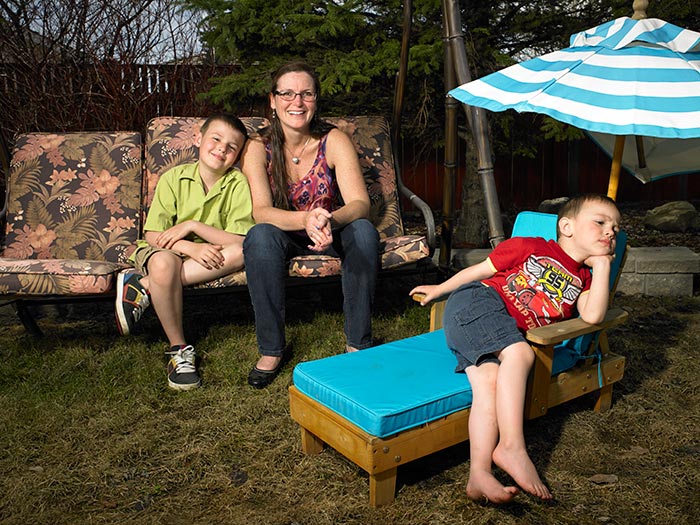
Fort McMurray is the latest inheritor of a regional tradition of boosterism, which holds that the fortunes of the West were built by pioneers—destined to grow ever bigger, braver, and bolder in memory—bent on wresting a living from its forests, prairies, waters, and mines. What gets passed over in the mythmaking is how many of them failed. While the varied functions and diversified economies of Regina, Winnipeg, Calgary, and other large cities enabled them to survive and thrive, the western hinterland is pockmarked with boom towns that are now nothing more than evocative names on the map.
In Ocean Falls, BC, a coastal pulp and paper town whose population topped 5,000 in the ’50s, split-level homes have become Sleeping Beauty’s castles in the rainforest, overgrown with brambles and blackberry bushes. Uranium City, Saskatchewan, where teenagers attended Candu High School as their fathers dug radioactive ore from the Eldorado Mine, is now a settlement of fewer than 200 on the north shore of Lake Athabasca. Posts on Alberta’s highways signal vanished towns like Windfall, Anthracite, Coalspur, and Bankhead, whose names recall the resource booms and busts that raised and ruined them.
The mills, docks, and rail lines that kept these early towns alive were woven into the very fabric of their streets. Fort McMurray, a distinctly twenty-first-century boom town, does a remarkably good job of insulating itself from the industry that makes its economy thrum. This is partly geography. The centre of Fort McMurray lies a good thirty kilometres upstream from the first of the big open-pit mines. The communities that really suffer are downstream. In Fort Chipewyan, a First Nations reserve and Alberta’s oldest settlement, cancer rates are 30 percent higher than in the rest of the country, and the moose meat is so laden with arsenic that residents have given up subsistence hunting. To the south, pipeline breaks affect communities, especially when they happen on farmland. (Two days after I arrive, a little-reported rupture in a CNRL pipeline begins, spilling 26,000 barrels of bitumen and water from the Athabasca sands into the boreal forest over ten weeks. To date, Alberta has experienced 28,666 such pipeline spills, about two a day, since 1975.)
Partly, though, the insulation is by design. On either side of the one highway that leads north, a Potemkin facade of replanted forests hides vast tailings ponds. Driving up to the first open-pit mine, you just catch peripheral glimpses of giant trucks raising dust on the horizon. On summer weekends, Fort McMurray Tourism takes fifty or so visitors on an official oil sands tour. The bus stops at a patch of reclaimed forest near Syncrude, where strategically placed platforms allow only a distant view of smokestacks. The foreground is occupied by a transplanted herd of wood bison, trucked in from the south and penned in by chain-link.
To really understand Fort McMurray, you need to get up in the air. In a region that is home to one of the largest civilian helicopter fleets on the continent, this turns out to be relatively easy. One morning, Ron Taylor tells me that Phoenix Heli-Flight is taking him for a tour in a shiny black Colibri. If I don’t mind riding shotgun, there is a seat for me up front. After a safety briefing, our pilot takes us over the downtown before shadowing the highway north. Within minutes, we are flying over Suncor’s Millennium site, one of the region’s oldest open-pit mines.
From 1,000 feet, there is no hiding the operation’s staggering reach. We hover low over the mine face. The “overburden”—which is how the industry refers to coniferous trees, wetlands, and muskeg—has been removed, and terraces of bare earth descend to the pit’s lowest point. A loader scrapes down the black, tar-impregnated sand from the mine face. Around it, yellow heavy haulers, the kind of dump trucks the Peckfords drive and service, wait to carry the earth away. Each is the size of a three-bedroom house, and the pit they work in could hold a twenty-four-storey building. The sweeping landscape of oil-slicked craters, rectangular tailings ponds, parched earth, and a cat’s cradle of dirt roads is beyond lunar. The boreal forest has been erased, probably forever.
We head west over the Athabasca River to Syncrude’s Mildred Lake site. Ziggurats of sulphur sit not far from the stacked barracks that house thousands of on-site workers. Every few hundred metres, a dust devil rises like a funnel of filth; without tree roots to hold it in place, the earth is at the mercy of the wind. Wood bison graze next to a patch of reclaimed forest that has been featured in television ads to defend the industry’s reclamation efforts. From the air, it is revealed as a minuscule stand of green on the edge of a tailings pond, where chemical- and oil-laden wastewater is left to evaporate. (On one of these ponds, 1,600 ducks died in 2008 when Syncrude employees failed to deploy sound cannons to frighten them away.) Tailings ponds alone total more than 170 square kilometres, forming what University of Alberta aquatic scientist David Schindler calls a “toxic Great Lake.”
All told, the bitumen sands contain about 170 billion barrels of proven reserves. The forest zone licensed for open-pit and in situ oil production is the size of Florida. After fifty years of mining, only 104 hectares of forest have been certified as fully restored—an area one-third the size of Manhattan’s Central Park.
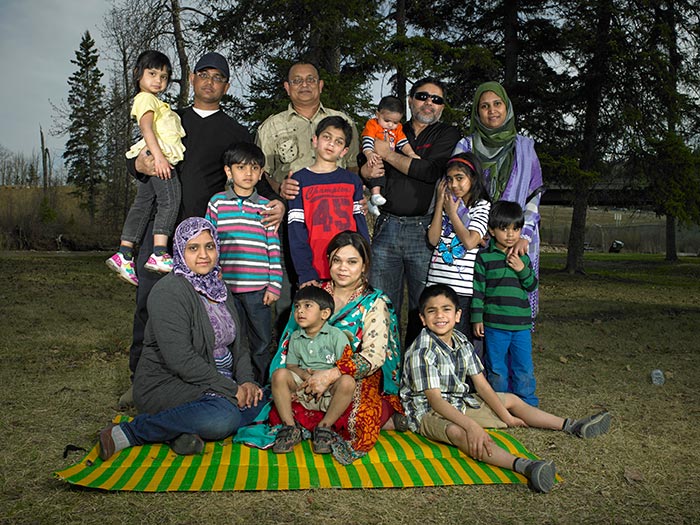
There’s a scene at the beginning of the sly comedy Fubar II, in which the movie’s heroes, two headbangers out to make their fortune in the Mac, pick up a tree-hugging hitchhiker. When the kid starts talking about water pollution and dead waterfowl, they decide to steal his weed stash by tricking him into pushing their car. (“I’d like to see it if you had to push a car for ten feet. Then you’d be like, ‘Kill all the ducks!’”.) As he heaves against the trunk, they peel out, leaving him on the side of Highway 63 like a road-killed chipmunk.
Kicking your conscience to the curb, I realize after a week, may be the only way to survive a place like Fort McMurray. “The bottom line,” says Todd, a firefighter from New Zealand who paid off all of his debts after three years here, “is that living here is like selling your soul—and you can only sell it for so long.”
Watching the shadow of our helicopter dance over deforested hillsides, I remind myself that I am part of the problem. By flying from Montreal to Fort McMurray, renting a mid-size car for a week, and going up in this helicopter, I have pumped one tonne of carbon into the atmosphere. As always, I’ve dutifully mitigated my footprint, contributing to an offset fund that promises to make all of my travel carbon neutral. It’s a Hail Mary on my part, with no guarantee that any of these efforts will actually have an impact on the global load of greenhouse gases. One thing is certain. I am responsible for my carbon emissions, and all week long (to borrow a memorable image from Al Gore), I have been treating the atmosphere like an open sewer.
I have listened to dozens of people explain what brought them to Fort McMurray. Some stories are banal, some tragic, some stirring. The vast majority of residents from elsewhere in Canada plan to stay for five years, ten tops, enough to pay off some debts or save for a down payment on a house. The ones most open to making a life here have no home to go back to. A Somali taxi driver, for example, grateful to have escaped a failed state. A Slovakian mother married to an Afghani engineer who doesn’t want her four-year-old son growing up surrounded by war and crime. A Moldovan housewife and her Ukrainian husband, whose eastern European academic qualifications were not accepted anywhere else in North America. For those from places ruined by resource busts, tanking economies, and internecine strife, a life here is better than what they left behind, especially with the oil companies dangling high salaries and rich benefits. But there is no avoiding the bitter truth: Fort McMurray’s is a multiculturalism of desperation.
Even the Peckfords, who had nothing bad to say about the town, plan to leave. When I was pulling on my shoes in their foyer, I asked if they would retire here. While Tracey looked away, Craig snorted: “No way. We’ve already got our escape plan worked out. We’ll be ending up on an island in the Caribbean.” By their mid-forties, even these most ardent defenders of the community will be gone.
It is impossible to visit Fort McMurray without considering what the city’s success will mean for the rest of us. In twenty years, the mid-size city could be overseeing the daily production of 6.9 million barrels of oil—equivalent to one-third of the amount used each day by the United States, by far the world’s most profligate consumer. As domestic fracking for shale oil and natural gas ramps up, American demand might plateau, but Alberta bitumen will almost certainly find other outlets. Enbridge’s Northern Gateway Project, now under review by the Harper government, would pipe oil over BC’s landslide-prone watersheds for shipment across the Pacific to supply China, whose thirst for energy will not likely abate any time soon. TransCanada’s proposed pipeline to New Brunswick is nearing approval, and by the end of this year, Suncor plans to ship tens of thousands more barrels a week to its refinery in Montreal’s east end. In other words, tar sands oil could conceivably pass, in the same type of railway container cars that laid waste to Lac-Mégantic, Quebec, less than a block from the home where my wife and I are raising our son.
Full exploitation of the Athabasca sands will put the world on track for a doubling of atmospheric carbon dioxide before the century’s end. By then, nobody will be dreaming of a happy retirement on a tropical island (thanks to melting polar ice and rising sea levels, many Caribbean destinations may be underwater.) Those still around will struggle to survive in a swamp-ridden world, beset by a climate last seen in the Eocene era, 56 million years ago.
“Alberta’s paying for your prosperity,” I was told by Fort McMurrayites, over and over. “Our oil money is bailing out the have-not provinces with transfer payments.” But Alberta’s wealth is directly attributable to the fact that, per capita, it emits 66.5 tonnes of greenhouse gases a year—versus a Canadian average of twenty—which puts it way ahead of Saudi Arabia as one of the world’s worst carbon emitters. That’s no kind of wealth I want to share. I don’t want to live in a world where oil spills take out whole ecosystems, exploding container cars gut entire communities, and catastrophic storms are just a normal part of the forecast. I don’t want my family’s future to be sacrificed to finance somebody else’s pimped-out trucks and early retirement. In short: I don’t want any part of a prosperity that is predicated on the destruction of the planet.
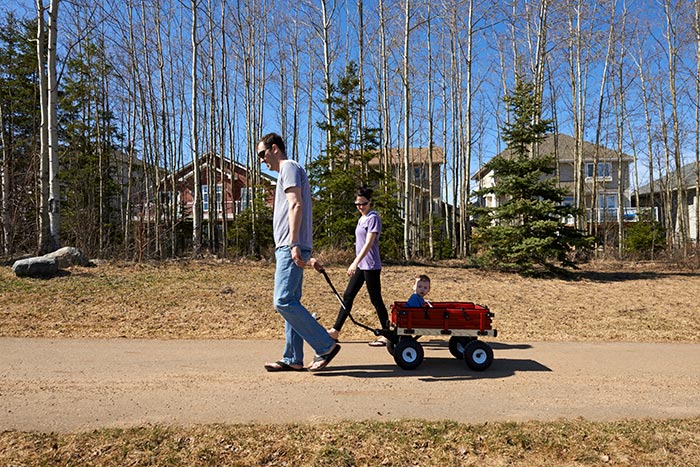
Three hours before I leave Fort McMurray, I decide to take one last walk in the boreal forest. The folks at the Oil Sands Discovery Centre (where the gift shop sells T-shirts with the motto Size Matters) recommend the Abasand trail, a short way from downtown. I hike along a winding dirt road past saskatoon berry bushes and dogwood blooming white. The forest is redolent with the piney smell of conifers, underlaid by a harsher odour, like asphalt baking in the hot sun. Eroded hillsides reveal its source: the dark earth oozes with naturally occurring tar. Beneath the tree roots lie the remains of a prehistoric sea whose organisms have been cooked into hydrocarbons, a Cretaceous period accident that sealed this forest’s fate in the Anthropocene epoch.
After I reach the Horse River, I come to the place where it all began. This is the bend in the river where, for generations, Cree stopped to use the natural tar to patch their birchbark canoes. This is also the site of the first real tar sands company, Abasand Oils, which during World War II produced 500 barrels of refined oil a day. Ruined buildings surround me, a collapsing stone chimney, and the white walls of coking shills, now covered with graffiti.
Something else surrounds me. Piles of junk, fast-food containers and pop bottles, old sinks and televisions, a wallet stripped of its contents except for a waterlogged photo of a father and son. The ground is littered with torched cars and trucks, the forest a boneyard of the internal combustion engine. In under a kilometre, I count a dozen vehicles, including a pickup with “RCMP Sucks” sprayed on one gaping door. In ironic eschatological juxtaposition, a gasoline-singed SUV sits atop flats of sun-baked bitumen. It looks like a portent of Fort McMurray’s future, a reminder that this single-resource boom town could become what Uranium City—or Abasand, or Anthracite, or Ocean Falls, or Windfall—turned into long ago.
A ghost town.
This appeared in the November 2013 issue.

